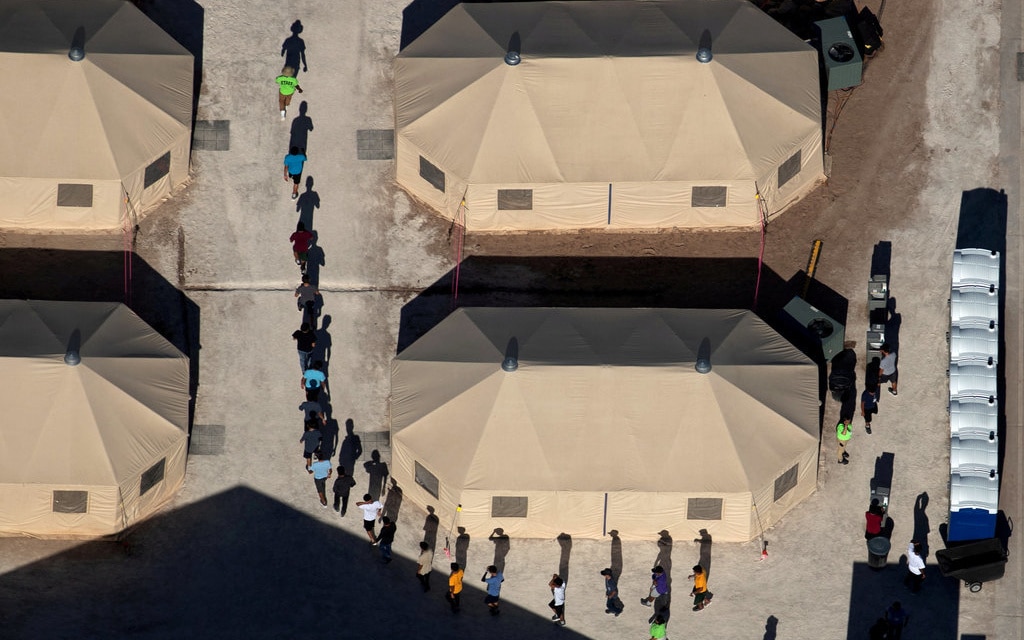“To avoid escape attempts, the moves are carried out late at night because children will be less likely to try to run away.”
Caitlin Dickerson writes for The New York Times about the secret movement of immigrant children to a tent city without adequate provision for education or legal representation:
In shelters from Kansas to New York, hundreds of migrant children have been roused in the middle of the night in recent weeks and loaded onto buses with backpacks and snacks for a cross-country journey to their new home: a barren tent city on a sprawling patch of desert in West Texas.
Until now, most undocumented children being held by federal immigration authorities had been housed in private foster homes or shelters, sleeping two or three to a room. They received formal schooling and regular visits with legal representatives assigned to their immigration cases.
But in the rows of sand-colored tents in Tornillo, Texas, children in groups of 20, separated by gender, sleep lined up in bunks. There is no school: The children are given workbooks that they have no obligation to complete. Access to legal services is limited.
These midnight voyages are playing out across the country, as the federal government struggles to find room for more than 13,000 detained migrant children — the largest population ever — whose numbers have increased more than fivefold since last year.
The average length of time that migrant children spend in custody has nearly doubled over the same period, from 34 days to 59, according to the Department of Health and Human Services, which oversees their care.
To deal with the surging shelter populations, which have hovered near 90 percent of capacity since May, a mass reshuffling is underway and shows no signs of slowing. Hundreds of children are being shipped from shelters to West Texas each week, totaling more than 1,600 so far.
The Rapidly Expanding, Unregulated Tent City
The camp in Tornillo operates like a small, pop-up city, about 35 miles southeast of El Paso on the Mexico border, complete with portable toilets. Air-conditioned tents that vary in size are used for housing, recreation and medical care. Originally opened in June for 30 days with a capacity of 400, it expanded in September to be able to house 3,800, and is now expected to remain open at least through the end of the year.
“It is common to use influx shelters as done on military bases in the past, and the intent is to use these temporary facilities only as long as needed,” said Evelyn Stauffer, a spokeswoman for the Health and Human Services Department.
Ms. Stauffer said the need for the tent city reflected serious problems in the immigration system.
“The number of families and unaccompanied alien children apprehended are a symptom of the larger problem, namely a broken immigration system,” Ms. Stauffer said. “Their ages and the hazardous journey they take make unaccompanied alien children vulnerable to human trafficking, exploitation and abuse. That is why H.H.S. joins the president in calling on Congress to reform this broken system.”
But the mass transfers are raising alarm among immigrant advocates, who were already concerned about the lengthy periods of time migrant children are spending in federal custody.
The roughly 100 shelters that have, until now, been the main location for housing detained migrant children are licensed and monitored by state child welfare authorities, who impose requirements on safety and education as well as staff hiring and training.
The tent city in Tornillo, on the other hand, is unregulated, except for guidelines created by the Department of Health and Human Services. For example, schooling is not required there, as it is in regular migrant children shelters.
Mark Greenberg, who oversaw the care of migrant children under President Barack Obama, helped to craft the emergency shelter guidelines. He said the agency tried “to the greatest extent possible” to ensure that conditions in facilities like the one at Tornillo would mirror those in regular shelters, “but there are some ways in which that’s difficult or impossible to do.”
Under Cover of Darkness
Several shelter workers, who spoke on condition of anonymity for fear of being fired, described what they said has become standard practice for moving the children: In order to avoid escape attempts, the moves are carried out late at night because children will be less likely to try to run away. For the same reason, children are generally given little advance warning that they will be moved.
At one shelter in the Midwest whose occupants were among those recently transferred to Tornillo, about two dozen children were given just a few hours’ notice last week before they were loaded onto buses — any longer than that, according to one of the shelter workers, and the children may have panicked or tried to flee.
The children wore belts etched in pen with phone numbers for their emergency contacts. One young boy asked the shelter worker if he would be taken care of in Texas. The shelter worker replied that he would, and told him that by moving, he was making space for other children like him who were stuck at the border and needed a place to live.
Some staff members cried when they learned of the move, the shelter worker said, fearing what was in store for the children who had been in their care. Others tried to protest. But managers explained that tough choices had to be made to deal with the overflowing population.

